
Essential & Workforce Housing
Woodard kicked off his presentation by highlighting what he deemed to be the Dare County Board of Commissioners’ top priority and Dare County’s most pressing issue: constructing a series of rental housing projects throughout the county where essential members of the local workforce and their families can afford to live.
“The number one priority for us is essential and workforce housing,” said Woodard. “We’re trying to find solutions to make this happen. It’s been difficult, and we’ve been working on this for over two and a half years. Our goal is to ensure that the housing options are available for essential members of our community.”
Woodard told attendees that the county is diligently working toward its current goal of building a total of 400 to 500 units and that contracts have already been finalized with two developers: Woda Cooper Companies and Coastal Affordable Housing.
Woda Cooper Companies will use a combination of tax credits and $9 million in county funding to construct a total of approximately 100 units in Dare County, half of which are currently expected to be constructed at the Bowsertown Road site on Roanoke Island, with the remaining units to be built on another site that has yet to be determined by the developer. Coastal Affordable Housing will use $35 million in funding from the state of North Carolina that has been provided to Dare County for such projects. Woodard also informed attendees that Dare County recently purchased a parcel on Bernice Avenue in Manteo that will serve as the site of a future essential and workforce housing development.
In addition to detailing the progress that has been made on the essential and workforce housing front, Woodard also made a point to dispel any misconceptions that the proposed housing developments will be low-income or Section 8 housing. He emphasized that the people who will qualify for these units—which would range in cost from $900 to $1,800 per month—include members of local law enforcement, teachers, firefighters, EMS personnel and construction personnel, as well as hospital staff, hospitality industry staff, restaurant staff and retail staff, among other fields that are essential to the community.
Following his presentation on the county’s ongoing efforts and the recent strides that have been made to develop essential and workforce housing, Woodard invited special guest Trasa Rossi—who works as a seventh grade exceptional children’s teacher at First Flight Middle School in Kill Devil Hills—to share the challenges she faces when it comes to finding and securing housing within the community where she lives and works.
|
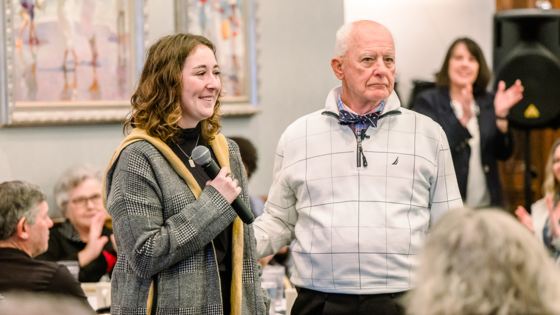 Image of Trasa Rossi speaking during the State of the County presentation.
Rossi moved to Dare County three years ago from Youngstown, Ohio, where she graduated from Youngstown State University with a bachelor’s degree in early childhood education and a special education degree for students in grades K-12. After relocating to the Outer Banks for her position, Rossi was able to secure a rental unit in a local teacher housing complex; however, due to restrictions on the amount of time these units can be rented, she will not have the option of renewing her lease when it ends next summer.
“I currently live in teacher housing; I’ve been there for almost three years now,” Rossi told State of the County attendees. “My three-year lease will be up August 11—and August 11, 2024 is when I either have to find housing or leave the area and my job.”
Knowing that her options are limited when her lease ends and that, due to the shortage of long-term rental housing units available in the area, Rossi has made every effort to plan ahead and save money in the hopes of being able to purchase a home so she can continue to live and work in Dare County.
“I have tried to do a lot of different side jobs to supplement my income in order to have a down payment for a home: I wait tables on the weekends, I have cleaned homes, I’ve tutored, I’ve done summer school, I’ve coached track—and right now, the homes that are on the market are outside of my debt-to-income ratio, and a lot of the mortgages are more than I make a month,” she said.
With current home prices outside her budget despite her extensive efforts to save for a downpayment, Rossi is continuing to search for a rental unit she can afford on her current salary so she isn’t forced to leave the area at the end of her lease.
“I am currently trying to find rental options in the area for when I have to leave teacher housing, and most of the rent that I find is $2,000 or more a month,” she said. “I was very blessed to have the job that I do and to live in this community, and I would love to stay here and continue to be a part of it.”
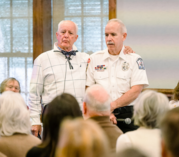
Beach Nourishment
Following the essential and workforce housing portion of his 2023 State of the County presentation, Woodard highlighted the importance of performing beach nourishment to replenish the sand that is lost due to erosion along the shoreline and also provided an overview of the numerous beach nourishment projects that were completed throughout Dare County in 2022.
“2022 was the year of beach nourishment on the Outer Banks,” said Woodard, noting that beach nourishment projects were successfully completed in the villages of Avon and Buxton on Hatteras Island, as well as the towns of Nags Head, Kill Devil Hills, Kitty Hawk and Southern Shores. The Town of Duck’s project—which had also originally been scheduled to take place in 2022—was rescheduled and is now slated to begin in March 2023.
Since 2011, Dare County has invested a total of $225 million to perform beach nourishment projects, the funding for which comes from a combination of town, state, FEMA and grant funds, as well as the county’s Beach Nourishment Fund, which is funded by a 2 percent portion of the 6 percent Occupancy Tax that is placed on local rental accommodations.
Woodard noted that Dare County’s wide, sandy beaches are not only an “economic engine” due to the millions of visitors they draw to the coastal communities of the Outer Banks each year—they also provide an essential buffer that protects infrastructure, such as N.C. Highway 12, which serves as a vital lifeline for residents, visitors and property owners alike.
Woodard then called on special guest Bill Laricos, a Maryland native and longtime resident of Hatteras Island who serves as an Advanced EMT for Dare County EMS and a captain for the Hatteras Island Rescue Squad. Woodard invited Laricos to share how shoreline erosion and ocean overwash has affected the ability of first responders to aid those in need of assistance due to medical emergencies and other life-threatening situations—and to tell attendees about the positive impact that beach nourishment projects have had when it comes to accessing patients and rendering aid in a timely manner.
|
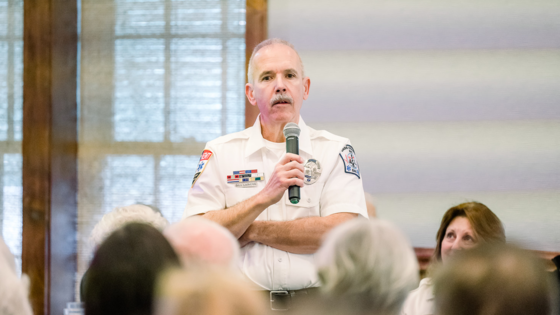 Image of Dare County EMS Advanced EMT Bill Laricos speaking during the State of the County presentation.
“I live in Avon, and my house sits right on Highway 12, so I can look out and see the water coming,” Laricos told the crowd. “We had a beach for many years, and when the beach disappeared, we got to a couple of years where [during] every major storm, every high tide, the water poured through under the houses and onto the highway—and Highway 12 became a lake with probably two feet of water, and it presented a bunch of problems for us.”
Laricos went on to explain how, prior to the beach nourishment project that was completed in Avon in June 2022, Dare County EMS personnel were forced to drive through the overwash on the highway in order to access patients and transport them to the hospital—a process that caused significant delays in rendering aid and potentially reduced many patients’ chances of surviving.
“For EMS, we have an expression that ‘time is tissue,’” Laricos explained. “On critical calls, we need to get patients to the hospital quickly. It’s a matter of survival. Every time we drive north, we have to drive through the water—unless the water is too deep, and then we call one of the fire departments to come with a military truck. We transfer the patient to that military truck and go through the water to another ambulance on the other side and do the trip to the hospital—and it eats up critical time.”
In addition to wasting valuable time during a call that could ultimately mean the difference between life and death for some patients in need of immediate assistance, ocean overwash on N.C. Highway 12 can also cause a significant amount of damage to Dare County EMS vehicles that is quite costly to repair.
“I take responsibility for an ambulance when I start my shift, and that ambulance costs $330,000. That is your ambulance. That’s your money,” said Laricos. “For me to drive that ambulance through the salt water—and it’s pure salt water—every time I go north breaks my heart—and it writes a check for maintenance on that ambulance that you all have to cash.”
Laricos went on to explain how the county’s efforts to widen the beach and provide a bigger buffer between N.C. Highway 12 and the Atlantic Ocean by nourishing 2.5 miles of shoreline in Avon last year has been a game-changer for first responders on Hatteras Island.
“For us, EMS, it was not a matter of convenience; it was not a matter of inconvenience. It was a matter for us of life and death,” he said. “Now that the beach is back, we’re back to normal.”
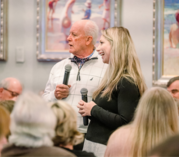
Maintaining Inlets & Waterways
Woodard’s 2023 State of the County presentation also emphasized the county’s ongoing efforts that are undertaken to ensure various channels and inlets throughout the area remain open and navigable for local commercial and recreational fishermen. Nowhere is the county’s commitment to keeping these waterways open better showcased than the completion of Miss Katie, the 156-foot-long shallow-draft hopper dredge that is tasked with helping to address the shoaling issues that occur within the region.
Miss Katie—which is the result of a yearslong collaboration between Dare County officials and EJE Dredging Service, who owns the dredge—departed from Conrad Shipyard in Louisiana on August 13, 2022, and on Friday, August 19, 2022, she officially arrived in Wanchese, which serves as the dredge’s homeport. From the time she arrived in Dare County through December 31, 2022, Miss Katie had already dredged a total of 103,019 cubic yards of sand from various waterways that have been plagued by shoaling that prevents many vessels from being able to safely navigate some channels and inlets in the area.
“[This project] was unheard of—had never happened before in the United States of America,” Woodard said of the development of Miss Katie. “Who can you count on, folks? You can count on this Dare County Board of Commissioners. That’s who you can count on to get things done and make things happen.”
Woodard went on to explain how Dare County allocates a considerable amount of local funding each year to perform dredging projects within essential waterways, including $3 million for Oregon Inlet and $250,000 for Hatteras Inlet.
“We’re going to keep our inlets open. We’ve made that commitment to our inlets and waterways,” he said. “These are the highways for our fishermen, recreational and commercial. To go to work—just like you and I go to work up and down this bypass out here—that’s what they [use] to go to work.”
Miss Katie operates under the direction of the Oregon Inlet Task Force, which is chaired by Dare County Commissioner Jim Tobin and of which Dare County Commissioner Steve House also serves as a commissioner. Having access to Miss Katie helps put dredging decisions under local control in Dare County and significantly reduces the county’s reliance upon the U.S. Army Corps of Engineers and the availability of their dredges to assist when shoaling occurs.
Funding for Miss Katie came from a public-private partnership with the state of North Carolina, in which the legislature allocated $15 million from the Shallow Draft Navigation Channel Dredging and Aquatic Weed Fund for the purchase of the dredge, which plays an integral role in keeping Dare County waterways safe and accessible.
To emphasize the impact that maintaining waterways throughout Dare County has on local watermen, Woodard invited Kait Daniels—who is the wife of fourth-generation commercial fisherman Boo Daniels—to share her husband’s experiences with shoaling-related issues and the impact that Miss Katie has had on both her family and the commercial fishing community of the Outer Banks as a whole.
|
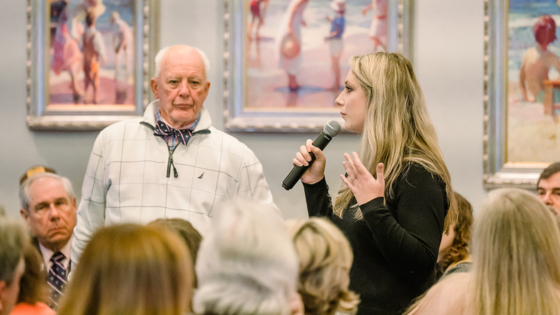 Image of Kait Daniels speaking during the State of the County presentation.
“He is a fourth-generation commercial fisherman from the Outer Banks, so he loves what he does,” Daniels told the crowd about her husband. “He grew up doing this as young as 5, making trips with his dad and his granddad, and he’s very fulfilled by his job. It really brings him a lot of joy. He’s passionate about responsibly bringing in fresh, local seafood to markets. It’s what he loves to do, and as his wife of nearly 10 years, I’m very grateful that he has a job that he loves so much. I wish it wasn’t so risky—that’s why we’re very thankful for the Miss Katie dredge and the work that it’s doing. If Boo were here, he would say that the state of the inlet is better than it has been in several years before the dredge.”
Daniels went on to share how her husband had struggled in the past to safely navigate around the shoaling in Oregon Inlet every time he embarked on one of the approximately 150 trips he takes each year to earn a living and provide for his family.
“He would really need to wait until high tide every trip just to have enough water to float across the bar, and that’s really dangerous. You don’t want to be on the bar when you know the tide's running and you can’t make it across—and that was something he was facing every time he left home to go fish,” she said. “So thanks to the dredge, he doesn’t have to wait until high tide anymore, which is great because it gives him more flexibility with how often he can go fishing and being able to come in safely when conditions aren’t OK.”
Daniels continued, “He has incurred damage over the years just trying to make it out the inlet. He’s taken waves over the barrel that have cracked his cabin and required a lot of work to be done. It’s really a dangerous living, and he loves it, so I’m very thankful for the dredge. It makes it safer for him to come and go and do his job, and I’m thankful for the [county’s] commitment to keep the dredge going. It’s really vitally important to families like ours.”

Commitment to Education
The next key issue Woodard highlighted during his presentation was the county’s commitment to providing top-notch educational opportunities to students of all ages within the community. Among the many ways Dare County supports local students is the significant financial investment that is made in the staff and students at Dare County Schools each year.
Over 38 percent of Dare County Schools’ budget is provided by county funding, with $22.8 million budgeted to the schools for the 2022-2023 fiscal year. An additional $1.3 million in the county’s budget also makes it possible to provide county-employed school nurses and resource officers at every public school in Dare County, and local per-pupil funding for Dare County Schools has ranked Dare County as the highest for county funding in the state of North Carolina for 19 of the last 20 years.
In addition to providing financial support to Dare County Schools, Woodard emphasized the county’s commitment to ensuring area students have the opportunity to earn a high-quality higher education at College of The Albemarle (COA) courtesy of the Dare Guarantee Scholarship. Each year, the Dare County Board of Commissioners provides $250,000 in funding for the Dare Guarantee Scholarship program, which was launched for the spring semester of 2020 and makes it possible for local students to attend COA’s Dare County campus in Manteo with no out-of-pocket costs for tuition or fees.
“We’ve had over 170 scholarships awarded in the last several years from the Dare Guarantee Scholarship program, about $275,000 total,” said Woodard. “It allows students to attend college full time with no out-of-pocket cost for tuition. Now, did you hear me say zero cost? Zero cost. I will say it again: zero cost. Who, as a parent, would not take advantage of that?”
Woodard also highlighted the county’s considerable financial investment in COA - Dare’s new academic building on Highway 64 in Manteo that was completed in April 2022 and offers students a state-of-the-art facility where they can attend classes in Dare County rather than commuting to and from the college’s campus in Elizabeth City.
“Let’s talk about higher education and College of The Albemarle’s $18 million facility right there,” said Woodard. “What a gateway to Manteo. It’s a beautiful building. I’d hold that building up against any four-year institution in the United States of America.”
To illustrate the impact the county’s commitment to education has had on local students in recent years, Woodard called on Zoe Heath Morris, a graduate of First Flight High School and Dare Guarantee Scholarship recipient who is currently attending COA - Dare and in the process of earning an associates degree in science.
|
 Image of Zoe Heath Morris speaking during the State of the County presentation.
“I have been born and raised here in this community. I chose COA for a couple reasons—it’s close to home, and I can get an amazing scholarship there: the Dare Guarantee. Why wouldn’t I take advantage of that?” asked Morris. “Going far away [for college] was not an option for me, as it’s just not something that is in my playing field. A lot of my friends went away, and I have been watching them, and they're like, ‘This is a lot being away from home,’ and the amount of money that they are spending and having to take out for loans. I’m so thankful that I can have two years free of college and be able to take advantage of that.”
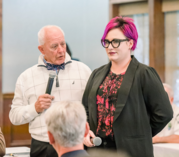
Combating the Substance Use and Opioid Crisis
For the fifth and final topic he addressed at the 2023 State of the County event, Woodard provided updates and information on an array of initiatives the county has launched in order to help combat the opioid and substance use crisis that affects so many individuals and families within the Outer Banks community.
Among these initiatives is the Saving Lives Task Force, a nonprofit organization that provides an assortment of important resources and support services to those struggling with substance use disorder and addiction throughout Dare County. Created in 2014, the Saving Lives Task Force is co-chaired by Dare County Board of Commissioners Vice Chairman Wally Overman, and Dare County Commissioner Ervin Bateman also serves as a member of its board.
In addition to the Saving Lives Task Force, Woodard also touched on the work being done at Outer Banks Dare Challenge—a residential substance abuse rehabilitation facility located in Wanchese that is currently in the process of undergoing a $6 million expansion project—as well as Dare County’s Recovery Court, a program that was developed in March 2019 to rehabilitate people who are facing criminal charges due to their substance use rather than incarcerating them for their crimes.
Woodard also offered details regarding Dare County’s plans to address the ongoing opioid crisis utilizing the national opioid settlement funds that were secured following a settlement with four pharmaceutical manufacturers and distributors. Of the $26 billion settlement, $750 million was allocated to North Carolina, with Dare County slated to receive a total of $3.4 million over the next 18 years.
Approximately $420,000 in funding has been designated for Fiscal Year 2023 and will be used to fund a local overdose response coordinator position, an additional probation officer for Recovery Court, community distribution of Naloxone and Fentanyl testing strips, a “Fentanyl Kills” mass public awareness campaign and various community initiatives.
Following his discussion of the series of dynamic ways Dare County is actively addressing the crisis, Woodard invited special guest Autumn Price—a recent graduate of Dare County’s Recovery Court program who struggled with substance use issues for several years—to share her story and experiences since successfully completing the program in December 2022.
|
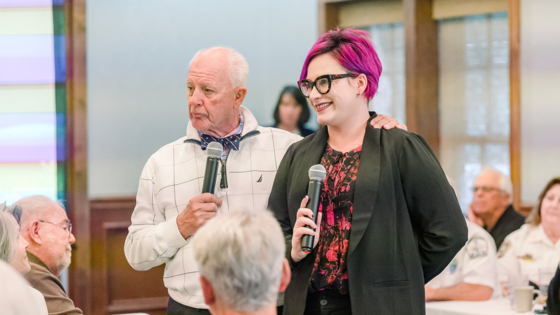 Image of Autumn Price speaking during the State of the County presentation.
“I actually moved to the Outer Banks about three and a half years ago after a path of self-destruction that landed me in a detox and a rehab,” said Price, who initially moved to the area to enter a sober living environment through a local nonprofit organization called the Oxford House. “I took a Greyhound and had $36 in my pocket. I lived in the Oxford House, took off, loved it, and I thought I was going to stay sober. I crashed and burned [at] 100 days. I relapsed. I relapsed very publicly shortly after speaking on behalf of Oxford House at a Saving Lives Task Force meeting. COVID hit at that point, and I was faced with multiple felony charges.”
Price continued, “I have a textile degree from North Carolina State University for design and textile engineering. At that point, I thought my life was over because felonies don’t allow people like me to have the jobs that I had. My kids were in foster care: I had one that was in care in Columbia, [North Carolina] and two that were in Tennessee. I was being threatened with my parental rights to be taken away. I was couch surfing, hotel surfing and living in a car—until I didn’t have a car—and I was offered the opportunity to go into [Dare County] Recovery Court as a result of my charges. I didn’t really know what to expect because I knew other county versions of Recovery Court, and they didn’t really leave a good taste in my mouth, but I did not want to go to jail, and I knew I wanted to get sober and stay sober. So I entered into Recovery Court.”
Once she entered Dare County’s Recovery Court, Price was offered the support and resources that she needed in order to help get her life back on track.
“I had a great support system, but the support that I found in Recovery Court offered me more stability and more responsibility. It not only taught me ‘don’t drink and drug,’ but it taught me how to communicate effectively what I was dealing with. They gave me resources to discover myself, and they taught me how to be a person without the drugs and the alcohol,” she said. “They taught me how to be a mother. They taught me how to be a friend, and, finally, they taught me how to be an advocate. But there are bad days, and Recovery Court offered me that extra encouragement that I needed to stay on the right path when I was struggling, whether it be with my mental health or with my substance abuse, or because I was missing my kids and didn’t have them, or whatever it may be. Recovery Court was there. The small tokens that we get through the 18 months for meetings—sobriety milestones—may not seem like a lot to most people here, but they meant something to me because somebody’s seeing me as more than just an addict. Someone is seeing me as more than just a felon.”
Since she graduated from Dare County Recovery Court in December 2022, Price has made it her mission to serve as an advocate for others in the Outer Banks community who are struggling with issues that are similar to those she has faced over the years.
“I wanted to show that [Recovery Court] worked. I see a lot of people come in, and they’re on fire like I was, and then they don’t get the results, and they don’t get their kids back, or they struggle with housing or jobs or whatever,” she said. “It’s disheartening because we’re more than our addiction; we’re more than our disease. I wanted to stay on and show people that there was a chance and that it does work if you work it. I finished my 18 months, and then I asked to stay as peer support. It’s been very rewarding. It’s opened up opportunities to me. I’m able to help with the recovery community now, and it’s been a saving grace.”
At the conclusion of his 2023 State of the County presentation, Woodard called the five special guests who shared stories detailing how the five top-priority issues that Dare County is currently tackling have impacted them to join him at the front of the room to be recognized alongside his fellow commissioners.
“Folks, this right here—these five people standing before you this morning—is where this group of men, the Board of Commissioners make it happen. That’s why they do what they do: so that we can produce and help people like this,” said Woodard.
Woodard continued by thanking everyone who attended the annual State of the County presentation and taking a moment to reflect on what he has learned in his role as chairman over the years.
“I want to close with what I’ve learned as chairman. I learned early—and learn every single day—that what we do for Dare County takes a village; it takes people like you sitting in this audience today. We’ve got elected officials here, school board elected officials and municipality elected officials. We have heads of the real estate industry and the construction industry—the list goes on and on. Those of you in this room today are stakeholders, movers and shakers, and you care about Dare County just like the Board of Commissioners cares about Dare County. We're blessed to be able to live and work in the county that we work and live in. Folks, we’ve got a lot of issues facing us. I could not, once again, be more proud of the 700—almost 800—employees that work for Dare County, as well as the Board of Commissioners and Board of Education. I could not be more proud to live in a county such as ours. God bless each and every one of you here today. Let’s make things happen.”
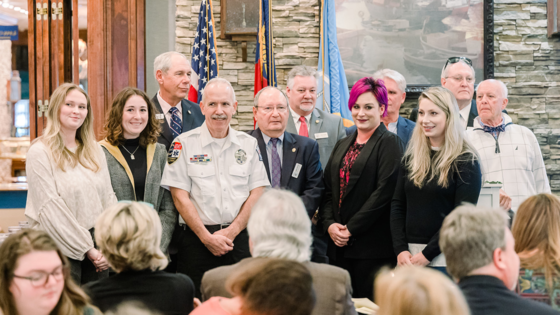 From left to right: Zoe Heath Morris, Trasa Rossi, Commissioner Rob Ross, Advanced EMT Bill Laricos, Vice-Chairman Wally Overman, Commissioner Steve House, Autumn Price, Commissioner Ervin Bateman, Kait Daniels, Commissioner Danny Couch and Chairman Bob Woodard.
For more information about the 2023 State of the County event, please visit www.DareNC.gov/SOC. To view a video of Chairman Woodard’s 2023 State of the County presentation on Dare County’s YouTube channel, please click the button below.
|